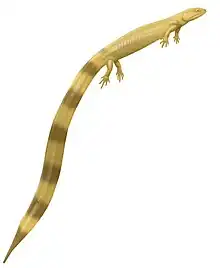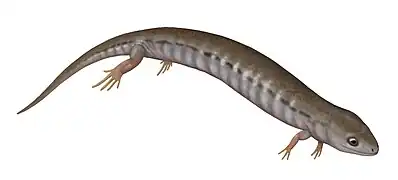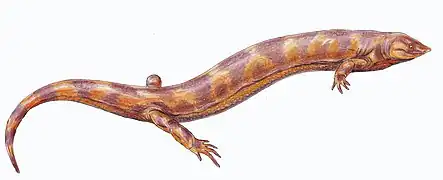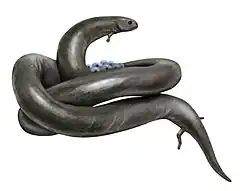| Recumbirostra Temporal range: Late Carboniferous - Early Permian, | |
|---|---|
 | |
| Life restoration of the rhynchonkid Rhynchonkos | |
 | |
| Life restoration of Batropetes, a brachystelechid | |
| Scientific classification | |
| Domain: | Eukaryota |
| Kingdom: | Animalia |
| Phylum: | Chordata |
| Superclass: | Tetrapoda |
| Clade: | †Recumbirostra Anderson, 2007 |
| Subgroups | |
|
see text | |
Recumbirostra is a clade of tetrapods which lived during the Carboniferous and Permian periods. They are thought to have had a fossorial (burrowing) lifestyle and the group includes both short-bodied and long-bodied snake-like forms.[1][2] At least one species, the long-bodied molgophid Nagini mazonense, lost its forelimbs entirely.[3] Recumbirostra includes the families Pantylidae, Gymnarthridae, Ostodolepidae, Rhynchonkidae and Brachystelechidae, with additional families such as Microbrachidae and Molgophidae being included by some authors.[4][5] Brachystelechidae and Molgophidae have also been grouped together in the suggested clade Chthonosauria.[6]
Recumbirostra was erected as a clade in 2007 to include many of the taxa traditionally grouped in "Microsauria", which has since been shown to be a paraphyletic or polyphyletic grouping.[7][8][9] Like other "microsaurs", the recumbirostrans have traditionally been considered to be members of the subclass Lepospondyli; however, many phylogenetic analyses conducted since the 2010s have recovered recumbirostrans as basal sauropsid amniotes instead.[10][7][5][3][11] Not all phylogenetic analyses recognize Recumbirostra as a valid grouping. An alternative clade called Tuditanomorpha is occasionally supported and includes many of the same taxa.[12]
Classification
Taxonomy
- Altenglanerpeton
- Sparodus
- Steenerpeton?
- Trihecaton?
- Hapsidopareiidae?
- Gymnarthridae
- Ostodolepidae
- Microbrachidae?
- Pantylidae
- Odonterpetidae
- Rhynchonkidae / Goniorhynchidae
- Chthonosauria
Phylogeny
Below is a cladogram showing the phylogenetic relationships of recumbirostrans from Glienke (2012):[4]
| Recumbirostra |
| ||||||||||||||||||||||||||||||||||||||||||||||||||||||||||||||||||||||||||||||||||||||||||||||||||||||
Gallery
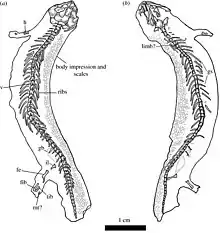 Skeleton of Joermungandr bolti, showing preserved remains of scales
Skeleton of Joermungandr bolti, showing preserved remains of scales Skeleton of the brachystelechid Batropetes
Skeleton of the brachystelechid Batropetes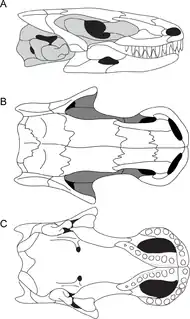 Skull of the molgophid Brachydectes
Skull of the molgophid Brachydectes Skull of the ostodolepid Nannaroter
Skull of the ostodolepid Nannaroter
References
- ↑ Mann, Arjan; Calthorpe, Ami S.; Maddin, Hillary C. (2021). "Joermungandr bolti, an exceptionally preserved 'microsaur' from the Mazon Creek Lagerstätte reveals patterns of integumentary evolution in Recumbirostra". Royal Society Open Science. 8 (7): 210319. doi:10.1098/rsos.210319. PMC 8292758. PMID 34295525.
- ↑ Mann, Arjan; Maddin, Hillary C (2019-09-30). "Diabloroter bolti, a short-bodied recumbirostran 'microsaur' from the Francis Creek Shale, Mazon Creek, Illinois". Zoological Journal of the Linnean Society. 187 (2): 494–505. doi:10.1093/zoolinnean/zlz025. ISSN 0024-4082.
- 1 2 Mann, Arjan; Pardo, Jason D.; Maddin, Hillary C. (2022-03-28). "Snake-like limb loss in a Carboniferous amniote". Nature Ecology & Evolution. 6 (5): 614–621. doi:10.1038/s41559-022-01698-y. ISSN 2397-334X. PMID 35347258. S2CID 247778148.
- 1 2 Glienke, S. (2012). "A new "microsaur" (Amphibia; Lepospondyli) from the Rotliegend of the Saar–Palatinate region (Carboniferous/Permian transition; West Germany)". Paläontologische Zeitschrift. 86 (3): 297–311. doi:10.1007/s12542-012-0130-8. S2CID 140699792.
- 1 2 Mann, A.; Pardo, J. D.; Maddin, H. C. (2019). "Infernovenator steenae, a new serpentine recumbirostran from the 'Mazon Creek' Lagerstätte further clarifies lysorophian origins". Zoological Journal of the Linnean Society. 187 (2): 506–517. doi:10.1093/zoolinnean/zlz026.
- ↑ Osteology and phylogenetic position of the diminutive 'microsaur' Odonterpeton triangulare from the Pennsylvanian of Linton, Ohio, and major features of recumbirostran phylogeny
- 1 2 Jason D. Pardo; Matt Szostakiwskyj; Per E. Ahlberg; Jason S. Anderson (2017). "Hidden morphological diversity among early tetrapods". Nature. 546 (7660): 642–645. Bibcode:2017Natur.546..642P. doi:10.1038/nature22966. hdl:1880/113382. PMID 28636600. S2CID 2478132.
- ↑ Anderson, J.S. (2007). "Incorporating ontogeny into the matrix: A phylogenetic evaluation of developmental evidence for the origin of modern Amphibians". In Anderson, J.S.; Sues, H.-D. (eds.). Major Transitions in Vertebrate Evolution. Bloomington and Indianapolis: Indiana University Press. pp. 182–227.
- ↑ Huttenlocker, A. K.; Pardo, J. D.; Small, B. J.; Anderson, J. S. (2013). "Cranial morphology of recumbirostrans (Lepospondyli) from the Permian of Kansas and Nebraska, and early morphological evolution inferred by micro-computed tomography". Journal of Vertebrate Paleontology 33 (3): 540.
- ↑ Jason D. Pardo, Matt Szostakiwskyj and Jason S. Anderson (2015). "Phylogenetic relationships of recumbirostran 'lepospondyls' inferred from neurocranial morphology". Society of Vertebrate Paleontology 75th Annual Meeting Program & Abstracts: 191.
- ↑ Mann, A.; Pardo, J. D.; Sues, H.-D. (2022). "Osteology and phylogenetic position of the diminutive 'microsaur' Odonterpeton triangulare from the Pennsylvanian of Linton, Ohio, and major features of recumbirostran phylogeny". Zoological Journal of the Linnean Society. 197 (3): 641–655. doi:10.1093/zoolinnean/zlac043.
- ↑ Henrici, A.C.; Martens, T.; Berman, D.S.; Sumida, S.S. (2011). "An ostodolepid 'microsaur' (Lepospondyli) from the Lower Permian Tambach Formation of central Germany". Journal of Vertebrate Paleontology. 31 (5): 997–1004. doi:10.1080/02724634.2011.596601. S2CID 129710688.
